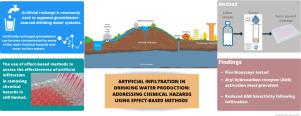Water Research ( IF 11.4 ) Pub Date : 2022-06-18 , DOI: 10.1016/j.watres.2022.118776 Maria Yu 1 , Shreya Mapuskar 1 , Elin Lavonen 2 , Agneta Oskarsson 3 , Philip McCleaf 4 , Johan Lundqvist 3

|
Artificial infiltration is an established managed aquifer recharge method that is commonly incorporated into drinking water processes. However, groundwater sourced from this type of purification method is prone to contamination with chemical hazards. Such an instance was previously shown at a Swedish DWTP where the river water was contaminated by hazardous chemicals during artificial infiltration. Further, there remains a paucity of research studying the quality of drinking water following this type of treatment from an effect-based bioanalytical perspective. In the current study, an effect-based assessment for chemical hazards was conducted for a Swedish drinking water system comprised of two DWTPs fed artificially-infiltrated river water. In this system, artificial infiltration of the river water takes approximately six to eight months. A sampling event was conducted in the autumn season and the samples were enriched by solid phase extraction. A panel of cell-based reporter gene assays representing several toxicity pathways was selected: oxidative stress response (Nrf2 activity), aryl hydrocarbon receptor (AhR) activation, and hormone receptor-mediated effects (estrogen receptor [ER], androgen receptor [AR]). AhR and ER bioactivities were detected in samples collected from the river intake and in the open-air infiltration basins prior to artificial infiltration. However, the AhR activity decreased and ER activity was effectively removed following artificial infiltration. In the Nrf2 and AR assays, no bioactivities above cut-off levels were detected in any samples collected along the entire treatment process of the drinking water production from source to tap. Using a suite of bioassays, the current study highlighted the effectiveness of artificial infiltration in reducing bioactive compounds in this raw river water. Although artificial infiltration is a common purification method in drinking water production, the limited number of effect-based studies evaluating the effectiveness of this method emphasizes the need for further research to better understand the risks and benefits of this water treatment process.
中文翻译:

饮用水生产中的人工渗透:使用基于效果的方法解决化学危害
人工入渗是一种成熟的管理含水层补给方法,通常被纳入饮用水处理过程。然而,来自这种净化方法的地下水容易受到化学危害的污染。这样的例子之前在瑞典的 DWTP 中展示过,在人工渗透过程中,河水被有害化学物质污染。此外,从基于效果的生物分析角度研究此类处理后的饮用水质量的研究仍然很少。在目前的研究中,对瑞典的饮用水系统进行了基于效果的化学危害评估,该系统由两个 DWTP 组成,喂入人工渗透的河水。在这个系统中,河水的人工渗透大约需要六到八个月。在秋季进行了一次采样活动,并通过固相萃取对样品进行了富集。选择了一组代表几种毒性途径的基于细胞的报告基因检测:氧化应激反应(Nrf2 活性)、芳烃受体 (AhR) 激活和激素受体介导的效应(雌激素受体 [ER]、雄激素受体 [AR] )。在人工渗透之前从河流取水口和露天渗透盆地收集的样品中检测到 AhR 和 ER 生物活性。然而,人工渗透后,AhR 活性降低,ER 活性被有效去除。在 Nrf2 和 AR 分析中,在从源头到水龙头的饮用水生产的整个处理过程中收集的任何样品中均未检测到高于临界水平的生物活性。目前的研究使用一套生物测定法,强调了人工渗透在减少原始河水中的生物活性化合物方面的有效性。虽然人工渗透是饮用水生产中常见的净化方法,但评估该方法有效性的基于效果的研究数量有限,强调需要进一步研究以更好地了解这种水处理过程的风险和益处。











































 京公网安备 11010802027423号
京公网安备 11010802027423号